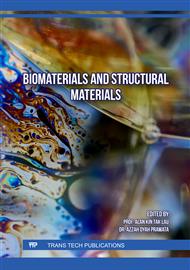[1]
The National Team for the Acceleration of Poverty Reduction (TNP2K), the Secretariat of the Vice President of Indonesia, conducted together with Traction Energy Asia. "Pemanfaatan Minyak Jelantah Untuk Produksi Biodiesel dan Pengentasan Kemiskinan di Indonesia". October 2020.
Google Scholar
[2]
Iasmin, M., Dean, L.O., Lappi, S.E., Ducoste, J.J., 2014. "Factors that influence properties of FOG deposits and their formation in sewer collection systems". Water Res. 49 (1935), 92–102
DOI: 10.1016/j.watres.2013.11.012
Google Scholar
[3]
Williams, J.B., Clarkson, C., Mant, C., Drinkwater, A., May, E., 2012. "Fat, oil, and grease deposits in sewers: characterisation of deposits and formation mechanisms". Water Res. 46 (19), 6319–6328
DOI: 10.1016/j.watres.2012.09.002
Google Scholar
[4]
He, X., de los Reyes, F.L., Leming, M.L., Dean, L.O., Lappi, S.E., Ducoste, J.J., 2013. "Mechanisms of fat, oil and grease (FOG) deposit formation in sewer lines". Water Res. 47 (13), 4451–4459
DOI: 10.1016/j.watres.2013.05.002
Google Scholar
[5]
Ortner, M.E., Müller, W., Schneider, I., Bockreis, A., 2016. "Environmental assessment of three different utilization paths of waste cooking oil from households". Resour. Conserv. Recycl. 106, 59–67
DOI: 10.1016/j.resconrec.2015.11.007
Google Scholar
[6]
Shiping, W. Wenjie, Z. Sang, Z. Zhenglong, J. and Dongsheng, Z., "Microbial conversion of waste cooking oil into Riboflavin by Ashbya gossypii", Biosci. J.,29 (4), 1000 (2013).
Google Scholar
[7]
Nitschke, M. and Costa, S. G. V. A. O., "Biosurfactants in food industry", Trends in Food Sci. Technol., 18, 252 (2007).
Google Scholar
[8]
S.M. van Ruth, M. Rozijn, A. Koot, R. Perez Garcia, H. van der Kamp, R. Codony, "Authentication of feeding fats: Classification of animal fats, fish oils and recycled cooking oils". Animal Feed Science and Technology, 155 (1) 2010.
DOI: 10.1016/j.anifeedsci.2009.09.016
Google Scholar
[9]
Kazuo, S. Kasukabe, J., US Pat. 5000870, Mimasu Oil Chemical Co., Ltd.,(1989).
Google Scholar
[10]
Ministry of Energy and Mineral Resources of the Republic of Indonesia, Press Release, Number: 388.Pers/04/SJI/2020, Date: December 6th, 2020. "Minyak Jelantah: Sebuah Potensi Bisnis Energi yang Menjanjikan"
Google Scholar
[11]
Putranti, Monika Larasati Tres Ayu, Sang Kompiang Wirawan, and I. Made Bendiyasa. "Adsorption of free fatty acid (FFA) in low-grade cooking oil used activated natural zeolite as adsorbent." In IOP Conference Series: Materials Science and Engineering, vol. 299, no. 1, p.012085. IOP Publishing, 2018.
DOI: 10.1088/1757-899x/299/1/012085
Google Scholar
[12]
Putra, Rudy Syah, Tatang Shabur Juliantoa, Puji Hartono, Ratih Dyah Puspitasaria, and Angga Kurniawan. "Pre-treatment of used-cooking oil as feed stocks of biodiesel production by using activated carbon and clay minerals." International Journal of Renewable Energy Development 3, no. 1 (2014): 33.
DOI: 10.14710/ijred.3.1.33-35
Google Scholar
[13]
Susilowati, Endang, Abu Hasan, and Aida Syarif. "Free fatty acid reduction in a waste cooking oil as a raw material for biodiesel with activated coal ash adsorbent." In Journal of Physics: Conference Series, vol. 1167, no. 1, p.012035. IOP Publishing, 2019.
DOI: 10.1088/1742-6596/1167/1/012035
Google Scholar
[14]
Rahayu, Sri, Supriyatin, and Adiati Bintari. "Activated carbon-based bio-adsorbent for reducing free fatty acid number of cooking oil." In AIP Conference Proceedings, vol. 2019, no. 1, p.050004. AIP Publishing LLC, 2018.
DOI: 10.1063/1.5061897
Google Scholar
[15]
Carla Salgado, Katherine Villaroman. "Free Fatty Acid Removal from Waste Cooking Oil Using Green Synthesized Magnetic Ferric Oxide as Pretreatment for Biodiesel Production". Thesis archieve. De la Salle University, Phillipine.
Google Scholar
[16]
Rahayu, Lucia Hermawati, and Sari Purnavita. "Regenerasi Minyak Jelantah Secara Adsorbsi Menggunakan Ampas Pati Aren dan Bentonit pada Berbagai Variasi Adsorben." In PROSIDING SEMINAR NASIONAL & INTERNASIONAL. 2014.
Google Scholar
[17]
Arsyad, Adam Shandy, and Rhyo Rura Bangalino. "Studi Pengaruh Ultrasonikasi Dan Aktivator Naoh Terhadap Pemurnian Minyak Jelantah Menggunakan Arang Aktif Granul Berbahan Dasar Tempurung Kelapa." PhD diss., Universitas Brawijaya, 2019.
DOI: 10.33795/distilat.v8i1.325
Google Scholar
[18]
Luthfia, Afifa, Azhari Azhari, Suryati Suryati, Sulhatun Sulhatun, and Meriatna Meriatna. "Penurunan Kadar FFA (Free Fatty Acid) Menggunakan Adsorben Dari Tempurung Kelapa." Chemical Engineering Journal Storage 1, no. 2 (2021): 1-10.
DOI: 10.29103/cejs.v1i2.5034
Google Scholar
[19]
Mardina, Primata, Erlyta Faradina, and Netty Setiawati. "Penurunan angka asam pada minyak jelantah." Jurnal kimia 6, no. 2 (2012): 196-200.
Google Scholar
[20]
SNI 3741:2013. Standard mutu minyak goreng
Google Scholar
[21]
SII No. 0258-88 (2003). Standard Mutu Karbon aktif
Google Scholar



